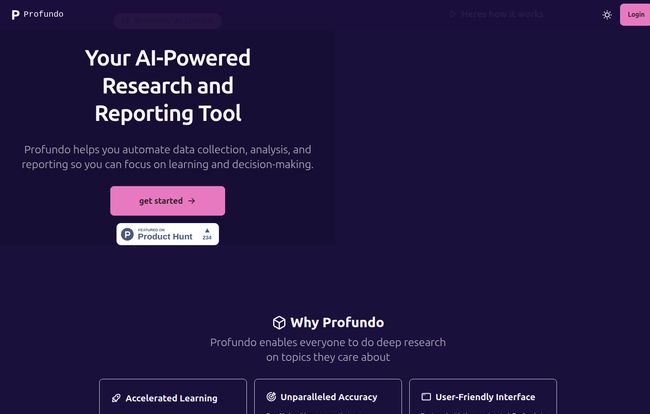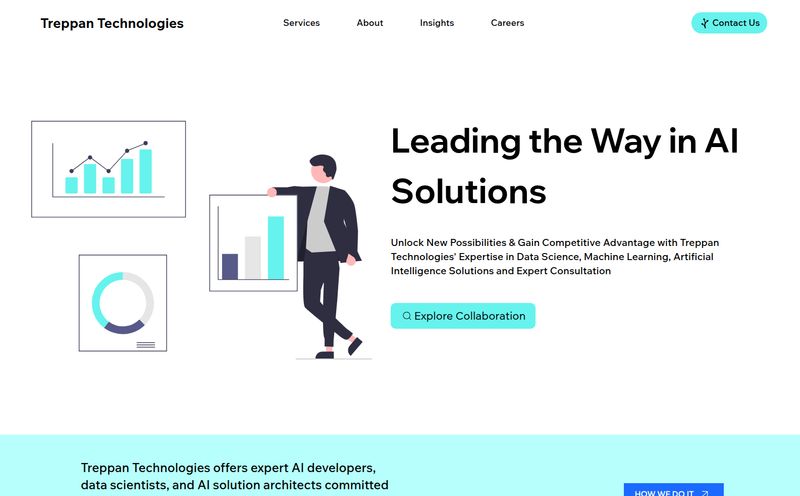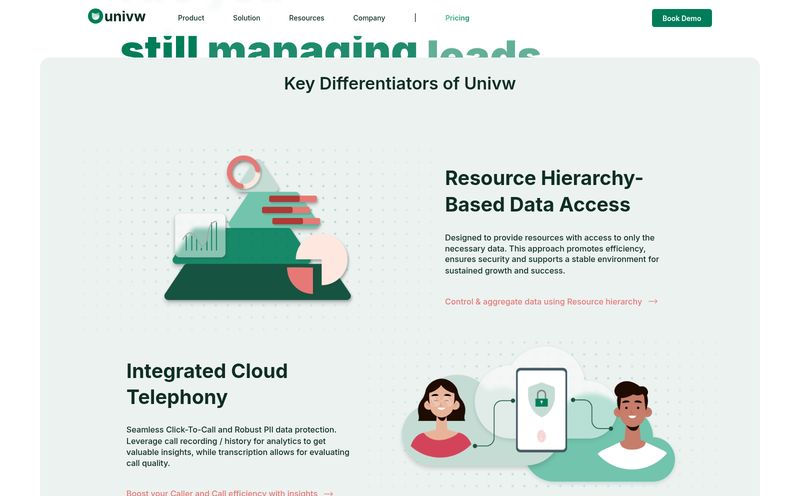If you’re in marketing, SEO, academia, or really any field that requires you to know things, your brain probably feels like a browser with 57 tabs open. One for competitor analysis, three for that deep-dive report your boss wants by Friday, another for a personal project, and a few more just playing cat videos. The sheer amount of information we need to process is... a lot. For years, the process has been the same: endless searching, copy-pasting links into a horrifyingly long document, and then trying to stitch it all together into something coherent. It’s a grind.
I’ve been in this game for a while, and I’ve seen countless tools that promise to be the “ultimate solution.” Most of them are just shiny wrappers on the same old thing. So when I came across Profundo, an AI-powered research platform, my professional skepticism was tingling. Another AI tool? Groundbreaking. But the promise wasn’t just about writing content; it was about automating the entire research-to-report pipeline. That… that got my attention.
So What Exactly Is Profundo, Anyway?
Think of Profundo less as a writer and more as a brilliant, lightning-fast research assistant. You know, the kind you wish you had in college. It’s an AI platform designed to handle the most tedious parts of research: the data collection, the analysis, and the initial reporting. You give it a topic—say, “The Future of Mobile Commerce in Southeast Asia”—and it scours web sources, academic papers, and news articles to gather relevant information. But it doesn't just dump a list of links on you. It analyzes the data to find patterns and trends, helps you create an outline, and then generates a summary or even a full draft. It’s meant to take you from zero to a well-researched 80% in a fraction of the time.
The big idea here is efficiency. The homepage boasts it has saved users over 16,000 hours. I don’t know how they calculate that, but after spending a weekend wrestling with a market research project, I can tell you that I believe it.

Visit Profundo
The Core Features That Actually Matter
A feature list is just a list until you see how it solves a real problem. Here’s what stood out to me from a practical, “I have a deadline tomorrow” perspective.
Rapid Data Discovery (But Faster)
This is the foundation of the tool. Profundo's ability to pull from sources beyond a simple Google search—like academic libraries and news archives—is a huge plus. For anyone doing serious SEO or content strategy, you know that sourcing data from reputable places is critical for E-E-A-T (Experience, Expertise, Authoritativeness, Trustworthiness). This feature helps build that authoritativeness right into your workflow. It’s like having a library card that works everywhere, instantly.
Deep Analysis Without the Headache
Okay, this is where the AI magic really happens. Once the data is collected, Profundo’s algorithms sift through it to identify patterns, trends, and key arguments. It’s looking for the signal in the noise. This is the part that usually takes me days, a gallon of coffee, and a very messy whiteboard. While it's impressive, this is also where I’d wave a small flag of caution. AI is that brilliant but sometimes overeager intern; it finds amazing connections, but you, the human expert, still need to verify its work. It gives you a massive head start, not a finished product you can blindly trust.
Bring Your Own Data. Yes, Please.
For me, this is a game-changer. Most AI research tools are limited to public web data. Profundo allows you to integrate your own proprietary data. Think about it: you can upload your company’s internal sales reports, customer surveys, or past market analyses and have the AI analyze it alongside public data. This creates a much richer, more contextual, and frankly, more valuable report. You're not just getting a summary of the internet; you're getting insights that are unique to your business.
Customized Reporting That Doesn't Look Generic
The final piece is getting the information out of the system and into a usable format. Profundo offers customized report generation. You can edit the outline, guide the summary, and shape the final document. This is crucial because nothing screams “I used an AI tool” like a generic, formulaic report. The ability to control the process and inject your own voice and structure is what separates a useful tool from a crutch.
Who Is This Tool Really For?
Based on their site and my own experience, I see a few key groups who would get a ton of value from this.
- The Academic or Student Drowning in Papers. The use cases for literature reviews, research, and dissertations are obvious. The ability to quickly synthesize dozens of scholarly articles is, frankly, a superpower for anyone in academia.
- The Marketer or SEO on a Deadline. Competitive analysis, market research, content ideation... this is our bread and butter. Instead of spending a day gathering intel on a competitor’s strategy, you could potentially get a solid brief in under an hour. That frees you up to focus on the so what—the strategy and execution.
- The Financial Analyst or Investor. The 'Industry' use case points directly to investment research. Sifting through financial news, market trends, and company reports to find an edge is the whole job. Profundo could act as a first-pass filter, highlighting opportunities or risks that warrant a closer look.
- The Curious Mind. Honestly, even for personal use like learning a new skill or just going down a rabbit hole, it's pretty powerful. It’s a structured way to learn quickly without getting lost in the chaos of the web.
Let's Talk Money: The Profundo Pricing Model
Pricing can make or break a tool for me. Profundo has a refreshingly simple, if potentially tricky, approach. It's not a flat monthly fee that you feel guilty for not using every day.
| Plan Type | Pricing Model | Key Features |
|---|---|---|
| Individual | Pay-as-you-go | Web, news, and scholar search; outline editing and summary generation. |
| Enterprise | Custom | All individual features plus custom data source integration. Requires contacting sales. |
The Pay-as-you-go model for individuals is interesting. It means you only pay for what you actually use, which is great for freelancers or people with sporadic research needs. However, this model is based on token consumption, a common practice for AI tools. It can be a double-edged sword. It's cost-effective if you're careful, but you could also burn through your budget on a complex project if you're not paying attention. It requires a bit of mindfulness about how you structure your queries.
The Enterprise plan is a classic “contact us” model, which makes sense given the custom data integration feature. This is for teams and companies who want to make Profundo a core part of their research infrastructure.
My Honest Take: The Good and The Not-So-Good
No tool is perfect, and anyone who tells you otherwise is selling something. In my experience, Profundo has some seriously compelling advantages. The time savings are real. The ability to automate the grunt work of data collection and synthesis is its biggest selling point, and it delivers on that promise. The interface is clean and user-friendly, which is more than I can say for some other “powerful” platforms that look like they were designed in 1998. And the option to integrate your own data is, for me, teh killer feature for any real business application.
On the flip side, you have to be smart about using it. That pay-as-you-go model could get expensive if you’re not disciplined. More importantly, and I can't stress this enough, you must not blindly trust the AI's output. It's a research assistant, not a replacement for your own critical thinking. You still need to validate the sources and sanity-check the conclusions it draws. Think of its report as a very, very good first draft that you, the expert, need to review and refine. It accelerates the process, it doesn’t eliminate your role in it.
Frequently Asked Questions About Profundo AI
- Is Profundo just for academic research?
- Not at all. While it's fantastic for academics, its use cases for industry professionals—like marketers, financial analysts, and consultants—are just as strong. It's built for anyone who needs to conduct deep research, for any purpose.
- How does the pay-as-you-go pricing work?
- It's based on token consumption, which is tied to the amount of processing your request requires. Simple searches cost less than complex analyses of large document sets. It's best to start with a small budget to get a feel for how quickly you use credits before committing to a large project.
- Can I trust the AI's analysis completely?
- I wouldn't. It's incredibly powerful for identifying patterns and summarizing information, but it's not infallible. Always treat the output as a highly-informed starting point. You should still review the key findings and cross-reference important data points yourself.
- What makes Profundo different from other AI writers like Jasper or ChatGPT?
- The main difference is the focus. AI writers are primarily for generating new text based on a prompt. Profundo is a research platform first. Its core strength is in aggregating and analyzing existing data from credible sources to build a foundation of knowledge before the writing even begins.
- Can I integrate my company's internal data?
- Yes, but this feature is part of the custom Enterprise plan. You'll need to contact their sales team to set up the integration for your proprietary data sources.
So, Is Profundo Worth Your Time?
After kicking the tires, my verdict is a pretty solid yes—with a caveat. If you're looking for a magic button that does all your thinking for you, this isn't it. But if you're a professional who respects the research process but hates the soul-crushing drudgery that comes with it, Profundo could become your new best friend. It’s a powerful accelerator.
It closes dozens of those mental tabs for you, organizing the chaos into a coherent starting point. It lets you focus your valuable brainpower on strategy, insight, and creativity—the parts of the job that a machine can't do. And in a world where we're all drowning in information, that's not just a nice-to-have. It’s a competitive advantage.



